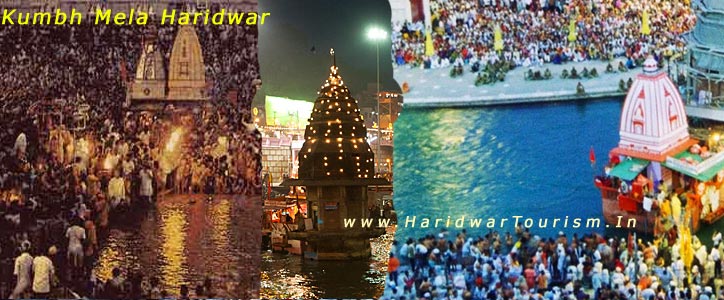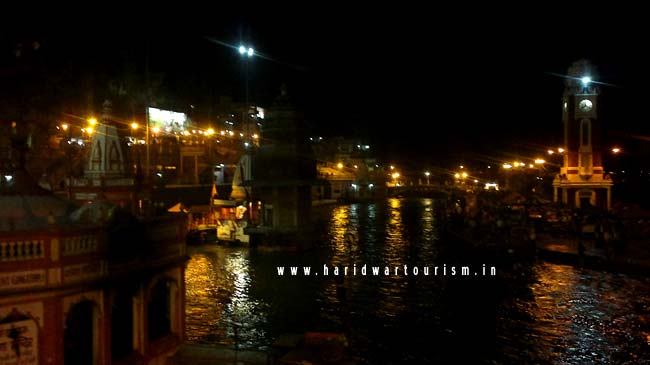|
|
 Kumbh
Mela - is billed as the "world’s largest congregation of religious
pilgrims" Kumbh
Mela - is billed as the "world’s largest congregation of religious
pilgrims"
Kumbh
Mela or Kumbha Mela is a mass Hindu pilgrimage of faith
in which Hindus gather to bathe in a sacred river. It is considered
to be the largest peaceful gathering in the world where around
100 million people were expected to visit during the Maha Kumbh
Mela in 2013 in Allahabad. Kumbh Mela is held every third year
at one of the four places by rotation: Haridwar, Allahabad (Prayaga),
Nashik and Ujjain. Thus the Kumbh Mela is held at each of these
four places every twelfth year. Ardha ("Half") Kumbh Mela is
held at only two places, Haridwar and Allahabad, every sixth
year. The rivers at these four places are: the Ganges (Ganga)
at Haridwar, the confluence (Sangam) of the Ganges and the Yamuna
and the mythical Saraswati at Allahabad, the Godawari at Nashik,
and the Shipra at Ujjain. The name Kumbh Mela comes from Hindi,
and in the original Sanskrit and other Indian languages it is
more often known as Kumbha Mela. Kumbha means a pitcher and
Mela means fair in Sanskrit.

The pilgrimage is held for about one and a half months at each
of these four places: it is believed in Hinduism that drops
of nectar fell from the kumbha carried by gods after the sea
was churned. Bathing in these rivers is thought to cleanse a
person of all sins. The festival is billed as the "world’s largest
congregation of religious pilgrims". There is no precise method
of ascertaining the number of pilgrims, and the estimates of
the number of pilgrims bathing on the most auspicious day may
vary. Approximately 80 million people were estimated to attend
on 14 February 2013.

Mythological origin of Kumbh Mela or Kumbha Mela According to
medieval Hindu theology, the origin of the festival is found
in one of the most popular medieval puranas, the Bhagavata Purana.
The Samudra manthan episode (Churning of the ocean of milk),
is mentioned in the Bhagavata Purana, Vishnu Purana, the Mahabharata,
and the Ramayana. The traditional account says that the Devas
had lost their strength by the curse of Durvasa Muni, and to
regain it, they approached Lord Brahma and Lord Shiva. They
directed all the demigods to Lord Vishnu and after praying to
Lord Vishnu, he instructed them to churn the ocean of milk Ksheera
Sagara (primordial ocean of milk) to receive amrita (the nectar
of immortality). They had to make a temporary agreement with
their arch enemies, the Asuras, to work together with a promise
of sharing the wealth equally thereafter. However, when the
Kumbha (urn) containing the amrita appeared, a fight ensued.
For twelve days and twelve nights (equivalent to twelve human
years), the Devas and Asuras fought in the sky for the pot of
amrita. It is believed that during the battle, Lord Vishnu (incarnated
as Mohini-Mürti) flew away with the Kumbha of elixir, spilling
drops of amrita at four places: Allahabad (Prayag), Haridwar,
Ujjain, and Nashik.
Kumbh
Mela Ardh Kumbha Mela Haridwar 2016 - We have started taking
booking for Kumbh Mela - 2016!!! For Bookings, Enquiries and
Early Discounts / offers... Contact us
The
next Ardh kumbh Mela will take place in the holy city of Haridwar
from January 2016 to April 2016.
Haridwar Ardh Kumbh Mela 2016 - Main Bathing (Snan) Dates:
| Date
(2016) |
Day |
Event |
| 14th
January |
Thursday |
Makar
Sankranti |
| 12th
February |
Friday |
Vasant
Panchami |
| 22nd
February |
Monday |
Magh
Purnima |
| 7th
March |
Monday |
Mahashivratri |
| 7th
April |
Thursday |
Chaitra
Amavasya |
| 8th
April |
Friday |
Chaitra
Shukla Pratipada |
| 14th
April |
Thursday |
Mesha
Sankranti |
| 15th
April |
Friday |
Ram
Navami |
| 22nd
April |
Friday |
Chaitra
shukla Purnima |
Bathing
Ghats in Haridwar
- Har Ki Pauri
- Asthi Pravath Ghat
- Subhash Ghat
- Gau Ghat
- Sapth Sarover Kshetra Ghat
- Sarvanand Ghat
- Pantdweep Ghat
- Kangra Ghat
- Roode Bale Wala Ghat
- Ganesh Ghat
- Varagi Camp Ghat
- Sati Ghat
- Daksheshwar Ghat
- Singh Dwar Ghat
-
Sita Ghat

|
|
|
|
